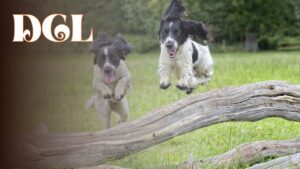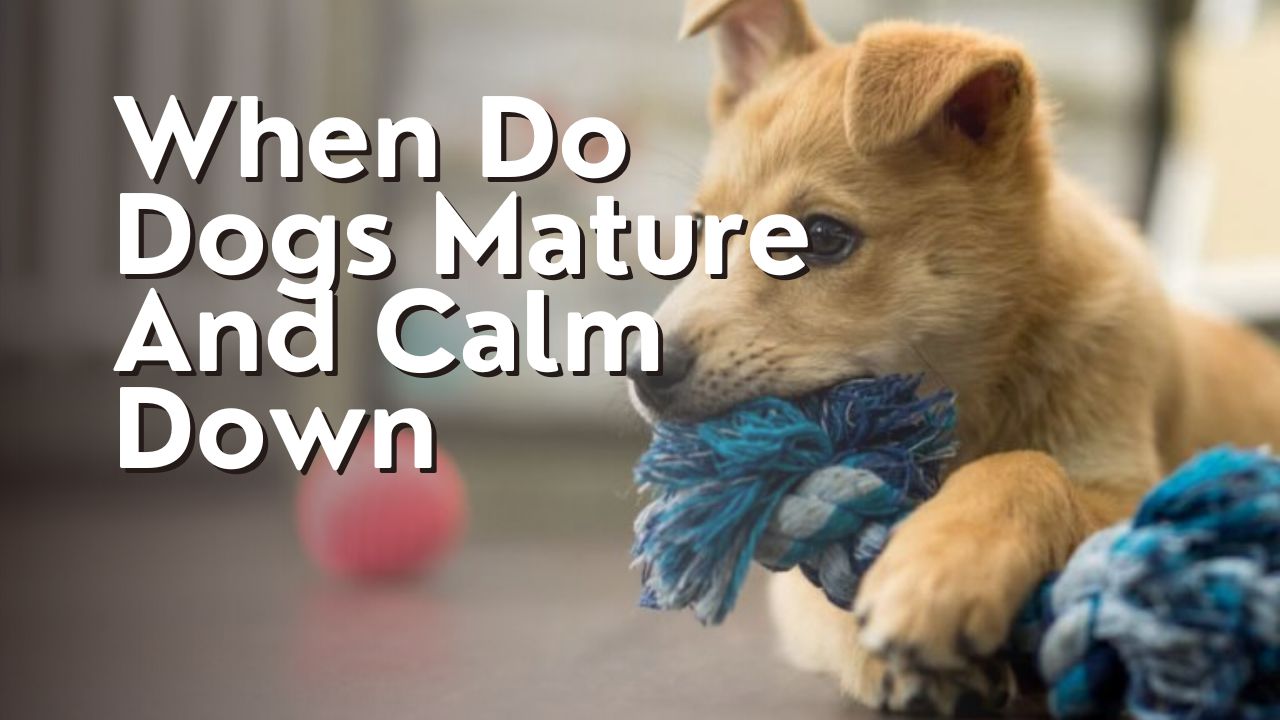Have you ever wondered when your furry friend will finally mature and calm down? Well, you’re in luck because in this article, I’ll be diving into the factors that affect a dog’s maturity, the different developmental stages they go through, and the signs to look out for when your dog starts to calm down.
Plus, I’ll share some helpful tips on how you can assist your dog in finding its inner zen.
So, let’s get started!
Factors Affecting a Dog’s Maturity
The factors that affect a dog’s maturity include its breed, size, and training. Different breeds mature at different rates, so it’s important to understand the characteristics of your specific breed.
Smaller breeds tend to mature faster than larger breeds, with some small breeds reaching maturity as early as one year old. On the other hand, larger breeds often take longer to mature and may not fully reach adulthood until they are two to three years old.
Training also plays a crucial role in a dog’s maturity. Dogs that receive consistent and proper training from a young age tend to mature faster and have better impulse control. Training helps them understand boundaries and expectations, which can contribute to their overall maturity. It’s important to note that training should be positive and reward-based, as punishment-based methods can have negative effects on a dog’s development.
Additionally, individual factors such as genetics and environment can also influence a dog’s maturity. Genetics can play a role in a dog’s temperament and behavior, while the environment they grow up in can shape their overall development. Providing a stable and nurturing environment can contribute to a dog’s emotional well-being and help them mature into well-adjusted adults.
Understanding these factors can help dog owners have realistic expectations about their pet’s maturity and be better prepared to meet their individual needs.

Developmental Stages in Dogs
During their developmental stages, you’ll notice that dogs go through periods of increased energy followed by periods of calmness. Just like humans, dogs go through various stages of development as they grow. These stages include the neonatal stage, the transitional stage, the socialization stage, the juvenile stage, and finally, the adult stage. Each stage is characterized by different physical and behavioral changes.
In the neonatal stage, which lasts from birth to around two weeks, puppies are completely dependent on their mother for survival. They are blind, deaf, and unable to regulate their own body temperature. The transitional stage, which lasts from two to four weeks, is a period of rapid growth and development. Puppies’ eyes and ears start to open, and they begin to explore their surroundings.
The socialization stage, which occurs from four to fourteen weeks, is a critical period for puppies. During this time, they learn how to interact with other dogs and humans and develop important social skills. The juvenile stage, which lasts from three to six months, is a time of increased energy and curiosity. Puppies may exhibit more independent behavior and start testing boundaries.
Finally, in the adult stage, dogs reach their full size and sexual maturity. They become more settled, both physically and mentally, and their energy levels start to stabilize. It is important to note that the exact timing of these stages can vary between different dog breeds and individual dogs.
| Developmental Stage | Age Range |
|---|---|
| Neonatal | Birth-2 weeks |
| Transitional | 2-4 weeks |
| Socialization | 4-14 weeks |
| Juvenile | 3-6 months |
| Adult | 1 year and above |
Understanding the different developmental stages in dogs can help us better care for and train them. It is important to provide appropriate socialization and training during critical periods to ensure that our furry friends grow into well-adjusted and balanced adults.
Signs of Maturity in Dogs
When it comes to signs of maturity in dogs, there are a few key points to consider.
Firstly, their energy levels tend to decrease as they grow older, allowing them to become more calm and relaxed.
Secondly, their focus and attention improve, making it easier for them to listen and follow commands.
Lastly, their destructive behaviors tend to reduce, as they become more well-behaved and less inclined to chew on furniture or dig up the backyard.
Decreased Energy Levels
As dogs mature, their energy levels tend to decrease. This is a natural part of their development and can be seen as a sign of their growing maturity. Here are three ways in which you may notice a decrease in your dog’s energy levels:
- Less hyperactivity: As dogs mature, they tend to become less hyperactive and more calm. They may no longer exhibit the same level of energy and excitement that they did when they were younger.
- Reduced playfulness: Older dogs often become less interested in playing and engaging in high-energy activities. They may prefer to spend their time resting or enjoying more relaxed forms of exercise.
- Longer naps: Mature dogs may start taking longer and more frequent naps throughout the day. This is because their bodies require more rest and recovery as they age.
Overall, a decrease in energy levels is a natural part of a dog’s maturation process and should not be a cause for concern.
Improved Focus and Attention
One noticeable change in a dog’s behavior as they get older is their improved focus and attention. When dogs are young, they can be easily distracted and have difficulty staying focused on a task or command.
However, as they mature, their ability to concentrate improves significantly. They become more attentive to their surroundings and are better able to understand and follow instructions. This improved focus and attention can be seen in various situations, such as during training sessions or when engaging in activities that require concentration, like playing fetch or solving puzzles.
It is important to note that while dogs may become more focused and attentive as they mature, it is still crucial to provide them with mental and physical stimulation to keep their minds sharp and prevent boredom.
Reduced Destructive Behaviors
To reduce destructive behaviors, you need to provide your aging dog with plenty of mental and physical stimulation. This will help channel their energy into productive activities and prevent them from resorting to destructive behaviors out of boredom or frustration. Mental stimulation can be achieved through interactive toys, puzzle games, and training sessions that challenge their mind. Physical exercise, such as daily walks or playtime at the park, is crucial to release pent-up energy and keep them physically fit. Additionally, providing your dog with a variety of chew toys helps satisfy their natural urge to chew and prevents them from destroying your furniture or belongings. Remember, a tired and mentally stimulated dog is a happy and well-behaved dog.
| Mental Stimulation | Physical Exercise |
|---|---|
| Interactive toys | Daily walks |
| Puzzle games | Playtime at park |
| Training sessions |
Tips for Helping Your Dog Calm Down
Try using calming techniques like gentle petting or providing a quiet space for your dog to relax. These methods can help your dog calm down and reduce their anxiety or hyperactivity.
When your dog is feeling stressed or overwhelmed, gently stroke their fur and speak to them in a soothing tone. This physical contact can help them feel secure and loved, which can in turn help them relax.
Additionally, creating a quiet space for your dog to retreat to can provide them with a sense of safety and comfort. This space can be a designated area in your home, such as a cozy corner with a soft bed or blanket. Make sure the space is free from distractions and noise, allowing your dog to have some peace and quiet.
Another tip for helping your dog calm down is to establish a routine. Dogs thrive on routine, as it provides them with a sense of predictability and stability. By establishing a consistent daily routine, you can help your dog feel more secure and calm. This routine can include regular exercise, feeding times, and designated play or relaxation times.
Finally, consider incorporating calming aids into your dog’s routine. There are various products available, such as calming collars, pheromone diffusers, or herbal supplements, that can help relax your dog. However, it’s important to consult with your veterinarian before using any calming aids to ensure they are safe for your dog.
Patience and Understanding
Having patience and understanding is crucial when helping your dog to relax. Dogs, like humans, have their own unique personalities and temperaments. Some dogs may naturally be more calm and relaxed, while others may be more energetic and excitable. It is important to remember that dogs mature at different rates, and what works for one dog may not work for another.
When it comes to helping your dog calm down, it is important to be patient. It may take time for your dog to learn how to relax and unwind. It is also important to understand that your dog’s behavior is not a reflection of their love for you or their desire to please you. Dogs have their own instincts and natural behaviors, and it is important to respect and understand these.
In addition to patience, it is important to have a good understanding of your dog’s needs. This includes providing them with plenty of exercise, mental stimulation, and a comfortable environment. Creating a routine and structure can also help your dog feel more secure and relaxed.
By having patience and understanding, you can help your dog navigate through their energetic and sometimes overwhelming moments. Remember, every dog is unique, and it may take time to find what works best for your furry friend. But with love and understanding, you can help your dog mature and calm down.

Frequently Asked Questions
Can early neutering or spaying affect a dog’s maturity and calmness?
Yes, early neutering or spaying can affect a dog’s maturity and calmness. It can help reduce aggressive behavior and calm down their energy levels, making them more manageable and easier to train.
Are certain dog breeds more prone to mature and calm down earlier than others?
Certain dog breeds may mature and calm down earlier than others. Factors such as breed characteristics, size, and individual temperament play a role. It is best to research specific breeds to determine their typical maturity and energy levels.
How can I distinguish between normal developmental stages and signs of maturity in my dog?
I can distinguish between normal developmental stages and signs of maturity in my dog by observing their behavior and physical changes. This includes their energy levels, trainability, and the completion of growth milestones.
Are there any specific training techniques that can help my dog become calmer?
There are specific training techniques that can help my dog become calmer. Regular exercise, mental stimulation, and positive reinforcement training can all contribute to a calmer and more well-behaved dog.
What role does the owner’s behavior and environment play in a dog’s maturity and calmness?
The owner’s behavior and environment have a significant impact on a dog’s maturity and calmness. Providing a stable and consistent routine, positive reinforcement training and a calm and balanced energy can greatly contribute to a dog’s overall well-being.
Conclusion
In conclusion, it is important to understand that every dog matures at their own pace. Factors such as breed, genetics, and environment can influence their development.
It is crucial for dog owners to be patient and provide their furry friends with the necessary guidance and training to help them calm down.
Remember, dogs may still exhibit occasional bursts of energy even after reaching maturity, but with love, consistency, and understanding, you can help your dog become a well-behaved and calm companion.


